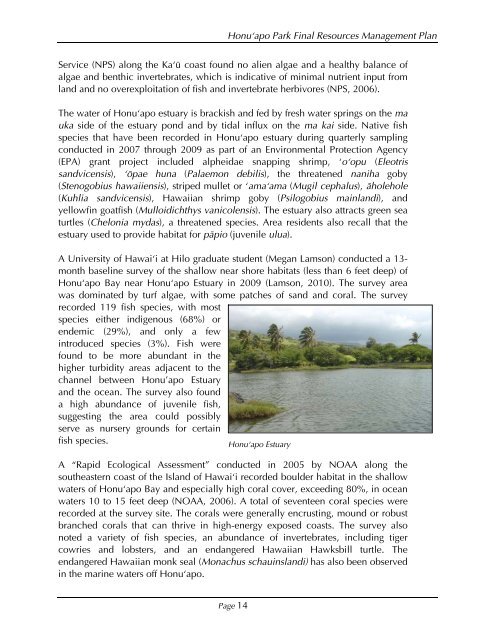Honu'apo Park Resource Management Plan
Honu'apo Park Resource Management Plan
Honu'apo Park Resource Management Plan
Create successful ePaper yourself
Turn your PDF publications into a flip-book with our unique Google optimized e-Paper software.
Honuÿapo <strong>Park</strong> Final <strong>Resource</strong>s <strong>Management</strong> <strong>Plan</strong><br />
Service (NPS) along the Kaÿü coast found no alien algae and a healthy balance of<br />
algae and benthic invertebrates, which is indicative of minimal nutrient input from<br />
land and no overexploitation of fish and invertebrate herbivores (NPS, 2006).<br />
The water of Honuÿapo estuary is brackish and fed by fresh water springs on the ma<br />
uka side of the estuary pond and by tidal influx on the ma kai side. Native fish<br />
species that have been recorded in Honuÿapo estuary during quarterly sampling<br />
conducted in 2007 through 2009 as part of an Environmental Protection Agency<br />
(EPA) grant project included alpheidae snapping shrimp, ÿoÿopu (Eleotris<br />
sandvicensis), ÿöpae huna (Palaemon debilis), the threatened naniha goby<br />
(Stenogobius hawaiiensis), striped mullet or ÿamaÿama (Mugil cephalus), äholehole<br />
(Kuhlia sandvicensis), Hawaiian shrimp goby (Psilogobius mainlandi), and<br />
yellowfin goatfish (Mulloidichthys vanicolensis). The estuary also attracts green sea<br />
turtles (Chelonia mydas), a threatened species. Area residents also recall that the<br />
estuary used to provide habitat for päpio (juvenile ulua).<br />
A University of Hawaiÿi at Hilo graduate student (Megan Lamson) conducted a 13month<br />
baseline survey of the shallow near shore habitats (less than 6 feet deep) of<br />
Honuÿapo Bay near Honuÿapo Estuary in 2009 (Lamson, 2010). The survey area<br />
was dominated by turf algae, with some patches of sand and coral. The survey<br />
recorded 119 fish species, with most<br />
species either indigenous (68%) or<br />
endemic (29%), and only a few<br />
introduced species (3%). Fish were<br />
found to be more abundant in the<br />
higher turbidity areas adjacent to the<br />
channel between Honu’apo Estuary<br />
and the ocean. The survey also found<br />
a high abundance of juvenile fish,<br />
suggesting the area could possibly<br />
serve as nursery grounds for certain<br />
fish species.<br />
Honuÿapo Estuary<br />
A “Rapid Ecological Assessment” conducted in 2005 by NOAA along the<br />
southeastern coast of the Island of Hawaiÿi recorded boulder habitat in the shallow<br />
waters of Honuÿapo Bay and especially high coral cover, exceeding 80%, in ocean<br />
waters 10 to 15 feet deep (NOAA, 2006). A total of seventeen coral species were<br />
recorded at the survey site. The corals were generally encrusting, mound or robust<br />
branched corals that can thrive in high-energy exposed coasts. The survey also<br />
noted a variety of fish species, an abundance of invertebrates, including tiger<br />
cowries and lobsters, and an endangered Hawaiian Hawksbill turtle. The<br />
endangered Hawaiian monk seal (Monachus schauinslandi) has also been observed<br />
in the marine waters off Honuÿapo.<br />
Page 14


